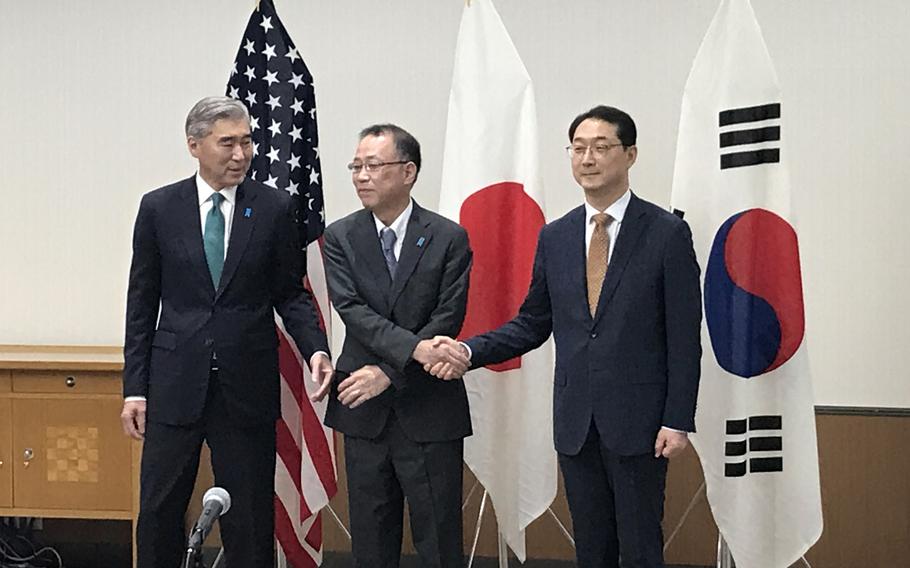
Sung Kim, left, the U.S. special representative for North Korea policy; Funakoshi Takehiro, center, director general of Japan's Asian and Oceanian Affairs Bureau at the Foreign Ministry; and Kim Gunn, South Korea's special representative for Korean Peninsula peace and security affairs, pose at Prince Hotel Karuizawa West in Nagano, Japan, Thursday, July 20, 2023. (Seth Robson/Stars and Stripes)
NAGANO, Japan — The United States is working to ensure the safety and return of a U.S. soldier who crossed into North Korea on Tuesday and has not been heard from since, a top U.S. diplomat told reporters Thursday in Japan.
Pvt. Travis King, 23, entered North Korea at the Joint Security Area, the site in the Demilitarized Zone separating North and South Korea. King reportedly left a tour group and bolted over a concrete curb separating the two countries.
“We are working very hard to ascertain information regarding his wellbeing,” U.S. special representative for North Korea policy Sung Kim told reporters at a meeting with his Japanese and South Korean counterparts in Nagano.
“We are actively engaging to ascertain his safety and return,” Kim said.
Pyongyang was not responding to U.S. attempts to communicate about King, The Associated Press reported Thursday. His flight into the severe, isolated regime comes at a difficult time in North Korea’s already fraught relations with the U.S. and the wider world.
King was released July 10 from a South Korean prison, where he had been held for six weeks on assault charges. U.S. Army authorities on Monday escorted him to a security checkpoint at Incheon International Airport, where he was scheduled for a flight to Fort Bliss, Texas, to face further disciplinary action and discharge.
But he never boarded the flight and instead turned up in a tour group at the border village of Panmunjom, where the 1953 Korean War armistice was signed and where he bolted across the dividing line, according to U.S. officials.
Kim met Thursday with Funakoshi Takehiro, director general of Japan’s Asian and Oceanian Affairs Bureau at the Foreign Ministry, and Kim Gunn, South Korean representative for Korean Peninsula peace and security affairs, to discuss North Korean issues at Prince Hotel Karuizawa West, a mountain golf resort and conference center.
Before King’s disappearance, the three-party talks were set against an increased tempo of North Korean weapons tests, including an intercontinental ballistic missile fired July 12, and the USS Kentucky, the first nuclear-armed ballistic missile submarine to visit South Korea in 42 years.
The talks also coincided with warming relations between South Korea and Japan, long at odds over lingering issues such as Japan’s use of Korean forced labor during its 1910-1945 occupation of the peninsula.
South Korean President Yoon Suk Yeol met Japanese Prime Minister Fumio Kishida in Tokyo in March. The following month, Yoon visited President Joe Biden at the White House. In May, Kishida called on Yoon in Seoul, the first such visit in 12 years.
The communist regime has fired 17 ballistic missiles in 12 separate days of testing so far this year.
In response, the U.S. and South Korea have increased the pace and scale of their military training and fielded their own displays of air and sea power with U.S. B-52 bombers escorted by allied fighters overflying the peninsula and visits by U.S. aircraft carriers and submarines.
North Korea fired two short-range ballistic missiles into its eastern sea early Wednesday in an apparent show of force the day after the Kentucky sailed into Busan, the largest port in South Korea.